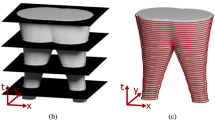Abstract
Kinetic data structures represent an extension to ordinary data structures, where the underlying data become time dependent (e.g. moving points). In this paper, we define the kinetic locally minimal triangulation (KLMT) as a kinetic data structure extension to the locally minimal triangulation in the Euclidean plane. We explore the general properties of this data structure in order to show what types of events need to be considered during its life cycle; we also describe the predicates associated with these events. To describe the general kinetic features, we prove that KLMT is responsive, compact, efficient and non-local. In the combinatorial analysis of KLMT, we briefly describe the mathematical apparatus commonly used to investigate computational complexity properties of kinetic data structures and use it to establish the bounds on the number of events processed during the life cycle of this data structure. Finally, the obtained results are compared to the kinetic Delaunay triangulation showing that KLMT may provide some benefits over kinetic Delaunay triangulation, namely simplifying the mathematical equations that need to be computed in order to obtain the times of events.





Similar content being viewed by others
References
Agarwal, P.K., Basch, J., de Berg, M., Guibas, L.J., Hershberger, J.: Lower bounds for kinetic planar subdivisions. Discr. Comput. Geom. 24(4), 721–733 (2000). https://doi.org/10.1007/s004540010060
Albers, G., Guibas, L.J., Mitchell, J.S.B., Roos, T.: Voronoi diagrams of moving points. Int. J. Comput. Geom. Appl. 8(3), 365–380 (1998). citeseer.ist.psu.edu/albers95voronoi.html
Basch, J.: Kinetic data structures. Ph.D. thesis, Stanford University (1999)
Basch, J., Guibas, L.J., Hershberger, J.: Data structures for mobile data. J. Algorithms 31(1), 1–28 (1999)
Basch, J., Guibas, L.J., Silverstein, C.D., Zhang, L.: A practical evaluation of kinetic data structures. In: Proc. 13th Annu. ACM Sympos. Comput. Geom, pp. 388–390. ACM Press (1997)
Beni, L.H.: Development of a 3D kinetic data structure adapted for a 3D spatial dynamic field simulation. Ph.D. thesis, Université Laval, Québec (2009)
Bose, P., Devroye, L., Evans, W.: Diamonds are not a minimum weight triangulation’s best friend. Int. J. Comput. Geom. Appl. 12(06), 445–453 (2002). https://doi.org/10.1142/S0218195902000979
Dickerson, M.T., Montague, M.H.: A (usually?) connected subgraph of the minimum weight triangulation. In: Proceedings of the Twelfth Annual Symposium on Computational Geometry, SCG ’96, pp. 204–213. ACM, New York (1996). https://doi.org/10.1145/237218.237364
Erickson, J., Guibas, L.J., Stolfi, J., Zhang, L.: Separation-sensitive collision detection for convex objects. In: SODA ’99: Proceedings of the tenth annual ACM-SIAM symposium on Discrete algorithms, pp. 327–336. Society for Industrial and Applied Mathematics, Philadelphia (1999)
Gavrilova, M., Rokne, J., Gavrilov, D.: Dynamic collision detection in computational geometry. In: 12th European Workshop on Computational Geometry, pp. 103–106. Munster, Germany (1996)
Goldenstein, S., Karavelas, M.I., Metaxas, D.N., Guibas, L.J., Aaron, E., Goswami, A.: Scalable nonlinear dynamical systems for agent steering and crowd simulation. Comput. Graph. 25(6), 983–998 (2001)
Goralski, I.R., Gold, C.M.: Maintaining the spatial relationships of marine vessels using the kinetic Voronoi diagram. In: ISVD ’07: Proceedings of the 4th International Symposium on Voronoi Diagrams in Science and Engineering, pp. 84–90. IEEE Computer Society, Washington (2007). https://doi.org/10.1109/ISVD.2007.30
Guibas, L.J.: Kinetic data structures: a state of the art report. In: WAFR ’98: Proceedings of the Third Workshop on the Algorithmic Foundations of Robotics on Robotics: The Algorithmic Perspective, pp. 191–209. A. K. Peters, Ltd., Natick, MA, USA (1998)
Guibas, L.J., Xie, F., Zhang, L.: Kinetic collision detection: algorithms and experiments. In: ICRA, pp. 2903–2910 (2001)
Heigeas, L., Luciani, A., Thollot, J., Castagné, N.: A physically-based particle model of emergent crowd behaviors. In: Graphicon (2003). http://artis.imag.fr/Publications/2003/HLTC03
Jaromczyk, J.W., Toussaint, G.T.: Relative neighborhood graphs and their relatives. Proc. IEEE 80(9), 1502–1517 (1992). https://doi.org/10.1109/5.163414
Kamphuis, A., Overmars, M.H.: Finding paths for coherent groups using clearance. In: SCA ’04: Proceedings of the 2004 ACM SIGGRAPH/Eurographics symposium on Computer animation, pp. 19–28. Eurographics Association, Aire-la-Ville, Switzerland (2004). https://doi.org/10.1145/1028523.1028526
Kolingerová, I., Ferko, A., Vomáčka, T., Maňák, M.: Nearest Neighbour Graph and Locally Minimal Triangulation, pp. 455–464. Springer, Cham (2017). https://doi.org/10.1007/978-3-319-62395-5_31
Kolingerová, I., Vomácka, T., Manak, M., Ferko, A.: Neighbourhood graphs and locally minimal triangulations. Trans. Comput. Sci. 33, 115–127 (2018). https://doi.org/10.1007/978-3-662-58039-4_7
Okabe, A., Boots, B., Sugihara, K., Chiu, S.N.: Spatial Tessellations: Concepts and Applications of Voronoi Diagrams. Probability and Statistics, 2nd edn. Wiley, Hoboken (2000)
Overmars, M.: Practical algorithms for path planning and crowd simulation. In: Proceedings of the 25th European Workshop on Computational Geometry (EuroCG), p. 263. Brussels, Belgium (2009). Invited speech
Richard Shewchuk, J.: Adaptive precision floating-point arithmetic and fast robust geometric predicates. Discr. Comput. Geom. 18(3), 305–363 (1997). https://doi.org/10.1007/PL00009321
Russel, D.: Kinetic data structures in practice. Ph.D. thesis, Stanford, CA, USA (2007). Adviser-Guibas, Leonidas
Sharir, M., Agarwal, P.K.: Davenport–Schinzel Sequences and Their Geometric Applications. Cambridge University Press, Cambridge (1995)
Sud, A., Andersen, E., Curtis, S., Lin, M., Manocha, D.: Real-time path planning for virtual agents in dynamic environments. In: SIGGRAPH ’08: ACM SIGGRAPH 2008 classes, pp. 1–9. ACM, New York (2008)
Treuille, A., Cooper, S., Popović, Z.: Continuum crowds. In: SIGGRAPH ’06: ACM SIGGRAPH 2006 Papers, pp. 1160–1168. ACM, New York (2006). https://doi.org/10.1145/1179352.1142008
Veltkamp, R.: The gamma-neighborhood graph. Comput. Geom. 1, 227–246 (1991)
Vomáčka, T., Kolingerová, I.: Computation of topologic events in kinetic Delaunay triangulation using sturm sequences of polynomials. In: SIGRAD 2008, pp. 57–64. University Electronic Press, Linköping (2008)
Acknowledgements
The authors would like to thank to RNDr. Svetlana Tomiczkova, Ph.D., from the Department of Mathematics of the Faculty of Applied Sciences at the University of West Bohemia for her invaluable help and proofreading of the text.
Funding
This work was funded by the Czech Science Foundation (Project Number 17-07690S) and by the Czech Ministry of Education, Youth and Sports (Project Number SGS-2019-016).
Author information
Authors and Affiliations
Corresponding author
Ethics declarations
Conflict of interest
The authors declare that they have no conflict of interest.
Additional information
Publisher's Note
Springer Nature remains neutral with regard to jurisdictional claims in published maps and institutional affiliations.
Rights and permissions
About this article
Cite this article
Vomáčka, T., Kolingerová, I. & Maňák, M. Kinetic locally minimal triangulation: theoretical evaluation and combinatorial analysis. Vis Comput 36, 757–765 (2020). https://doi.org/10.1007/s00371-019-01657-y
Published:
Issue Date:
DOI: https://doi.org/10.1007/s00371-019-01657-y




